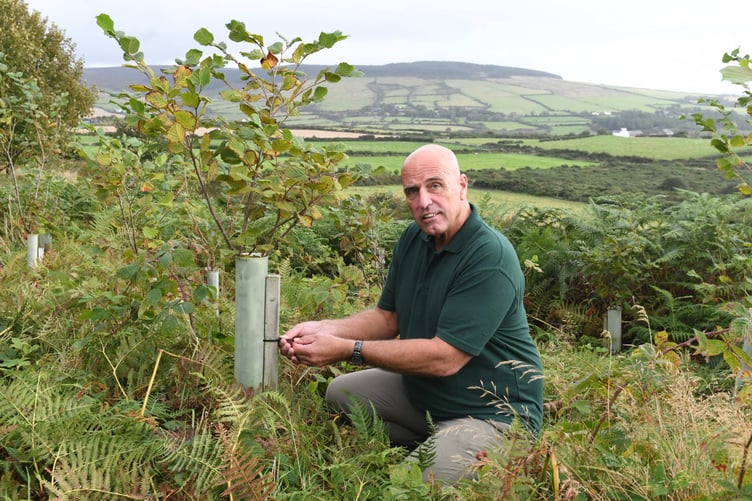In 2021, following approval by Tynwald, the DEFA launched the Woodland Grant Scheme (WGS).
The scheme is designed to support landowners, to encourage them to plant trees and shrubs and establish new woodlands that will benefit local wildlife, habitat connectivity and contribute to the capture and storage of atmospheric carbon dioxide.
The first step for anyone wanting to apply is an initial site assessment by the department’s woodland officer, Peter Keenan.
Peter said: ‘The most common reasons for people applying are to provide shelter and to benefit wildlife and most of the sites I have seen so far would qualify.
‘Some of the new woodland areas proposed are small, but remain vitally important as they will act as wildlife corridors, connecting habitats.
‘The department used to provide woodland creation assistance via the small woods scheme but this new scheme is slightly different. Previously, the department would do all the work, from planning to planting and the landowner invoiced for the work minus the grant support. With this new scheme, the landowner applies for the grant and once approved will need to undertake all the operational work themselves. Once completed the grant will be paid.
‘You lay out the capital spend yourself first.’
Applications can be made at any time, and depending on the type of new tree stock being purchased, trees can be planted nearly all year round, with the exception to very prolonged dry or drought conditions, which should be avoided.
Peter has worked for DEFA (and its predecessor organisations) since 1977, starting there before the era of forestry becoming almost completely mechanised.
He said: ‘I started off in the “gangs”, doing general labouring and maintenance. There was a lot of people employed there then, probably about 20 in total and the teams would vary in size.
‘It’s changed a lot now because we used to do the harvesting with chainsaws and tractors. Now it’s all mechanised with purpose-built harvesting and extracting machines.’
Peter studied forestry at Newton Rigg College in Penrith, Cumbria, and subsequently qualified to become a chainsaw instructor for DEFA. He also worked on the forestry expansion programme in the 1990s and before becoming the woodland officer was the department’s sawmill manager.
He can remember the days when the department had its own tree nursery where it grew all its own tree stock and even sold young trees to the general public. ‘One of the foresters even developed an apple variety, Andrew Johnson, named after him. It was a really good apple, a lovely eating apple, but it wouldn’t keep.
‘We had a lot of staff then, there were a lot of people working in forestry, but it became the case where it was more cost effective to buy the stock in from the UK.’
When it comes to which trees are eligible for planting under the new Scheme, the emphasis is on native species. And when it comes to choosing which ones, Peter is happy to advise on what would be most suitable, following the mantra ‘the right tree in the right place for the right reasons’.
He said: ‘I think the key is that you want texture and foliage, flowers and berries so for the likes of hawthorn you’ve got flowers in the spring and berries in the autumn, and the same with blackthorn.
‘And for the likes of rowan (also known as mountain ash) you’ve got the flowers in the spring and the berries in the autumn again but you also have that orange autumn leaf colour.
‘You could put some pine in an area, and some whitebeam, so you’ve got the dark colours of the pine and then, in the springtime, the whitebeam has a silver leaf so you’ve got the contrast of the silver leaf against the colour of the evergreen needles of the pine but you’ve also got the different textures as well.’
Hawthorn and mountain ash prefer drier areas whilst alder, goat willow and poplar are suitable where the ground is wetter.
Peter added: ‘If there are livestock around they probably won’t like the blackthorn or hawthorn but anything else, when you’re planting, just give it a metre from the fence so they can’t lean over and browse them.’
And, much as you might want to see the results of any planting as soon as possible, Peter advised that it is not a good idea to buy large expensive standard trees. These can be prone to increased failure rates and may not be eligible for grant assistance. He said: ‘In my experience, over a number of years, it is better to start with something smaller, around 60cms – within five years they could be as big as the standards or even bigger on the better sites.
‘If you’re ordering your stock, choose trees that are ideally between 30-90cms tall. And source your trees from an experienced tree nursery that grows its trees from seed in the UK.’
l For more information or to apply for the woodland grant scheme you can call the agriculture and lands directorate on 695701 or email [email protected].

.png?width=209&height=140&crop=209:145,smart&quality=75)

.jpeg?width=209&height=140&crop=209:145,smart&quality=75)
.jpeg?width=209&height=140&crop=209:145,smart&quality=75)
Comments
This article has no comments yet. Be the first to leave a comment.